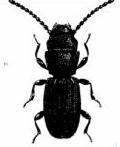Fumigation vs Sanitizing for Weevil Infestation in Food Silo
 Food storage silos are essential components of the food supply chain, providing a controlled environment for storing grains, seeds, and other commodities.
Food storage silos are essential components of the food supply chain, providing a controlled environment for storing grains, seeds, and other commodities.
However, these storage facilities are vulnerable to infestations by pests such as weevils, which can cause significant damage to stored goods.
Fumigation and sanitization are two common methods employed to prevent and manage weevil infestations in food storage silos.
Below, we compare these methods in terms of effectiveness, safety, environmental impact, and practical considerations.
Effectiveness
Fumigation: Fumigation involves the introduction of toxic gases, such as phosphine or methyl bromide, into the silo to eliminate pests. Fumigation is highly effective at killing adult weevils, larvae, and eggs throughout the silo, reaching areas that may be inaccessible during other treatments.
Sanitization: Sanitization focuses on cleaning and disinfecting the silo and its surroundings to remove food residues, moisture, and other factors that attract and support weevil infestations. While sanitization does not directly kill weevils, it can disrupt their breeding and feeding habitats, making the silo less hospitable to pests.
Safety
Fumigation: Fumigation involves the use of hazardous chemicals, posing risks to human health and safety if not handled properly. Workers must follow strict safety protocols, including wearing protective equipment and ensuring proper ventilation during and after fumigation.
Sanitization: Sanitization methods typically involve the use of non-toxic cleaning agents and disinfectants, posing fewer health and safety risks to workers. However, precautions should still be taken to prevent slips, trips, and falls during the cleaning process.
Environmental Impact
Fumigation: Fumigation with chemicals like methyl bromide can have adverse effects on the environment, including air and water pollution, as well as harm to non-target organisms. Due to environmental concerns, many countries have restricted or banned the use of methyl bromide for fumigation purposes.
Sanitization: Sanitization methods that utilize eco-friendly cleaning agents and practices have minimal environmental impact. Proper waste disposal and recycling of cleaning materials further reduce the ecological footprint of sanitization.
Practical Considerations
Fumigation: Fumigation is typically conducted by trained professionals using specialized equipment, making it a costly and time-consuming process. Additionally, fumigated silos may require aeration to remove residual gases before the stored goods can be reintroduced safely.
Sanitization: Sanitization can be carried out by on-site personnel using readily available cleaning supplies and equipment. While sanitization may require more frequent maintenance compared to fumigation, it offers a proactive approach to pest management and promotes overall hygiene in the silo.
Conclusion
Both fumigation and sanitization play important roles in preventing and managing weevil infestations in food storage silos. While fumigation offers a highly effective solution for eliminating existing pests, sanitization provides ongoing maintenance and hygiene practices to deter future infestations. Ultimately, the choice between fumigation and sanitization depends on factors such as effectiveness, safety, environmental impact, and practical considerations, which should be carefully evaluated based on the specific needs and circumstances of the food storage facility.
What is the options
Apart from fumigation and sanitization, there are several other options available for preventing and managing weevil infestations in food storage silos. These alternatives focus on mechanical, biological, or natural methods to control pests. Here are some examples:
- Heat Treatment: Heat treatment involves raising the temperature inside the silo to levels that are lethal to pests, including weevils. This method effectively kills all life stages of the pest, including eggs, larvae, and adults, without the use of chemicals. Heat treatment can be conducted using specialized equipment such as heaters or steam generators.
- Modified Atmosphere Storage (MAS): MAS involves altering the atmosphere inside the silo by reducing oxygen levels or increasing carbon dioxide levels to create conditions inhospitable to pests. This method slows down the metabolism of pests, preventing their growth and reproduction. However, it requires precise monitoring and control of gas levels to ensure the safety and quality of stored food products.
- Physical Barriers: Installing physical barriers such as screens, traps, or seals can prevent pests like weevils from entering or exiting the silo. Mesh screens placed over ventilation openings can prevent insects from entering, while traps placed inside the silo can capture and monitor pest populations. Sealing cracks, gaps, and entry points can also help prevent pest entry.
- Biological Control: Biological control involves using natural enemies or predators of weevils to reduce their populations. For example, introducing parasitic wasps or predatory beetles that feed on weevil eggs or larvae can help control infestations. However, biological control methods may require careful monitoring to prevent unintended ecological consequences.
- Integrated Pest Management (IPM): IPM combines multiple pest control strategies, including monitoring, prevention, and control methods, to minimize the use of pesticides and reduce environmental impact. It emphasizes regular inspections, proper storage practices, sanitation, and the use of non-chemical control methods. IPM programs are tailored to specific pests and storage conditions.
- Inert Dusts: Inert dusts, such as diatomaceous earth or silica gel, can be applied to surfaces inside the silo to disrupt the cuticle of insects, causing dehydration and death. These dusts are relatively safe for humans and the environment but require reapplication over time as they lose effectiveness.
- Electromagnetic Pest Control: Electromagnetic pest control devices emit electromagnetic waves that disrupt the nervous systems of pests like weevils, repelling them from the silo. While these devices are non-toxic and environmentally friendly, their effectiveness may vary, and they are often used in combination with other control methods.
These alternative methods offer environmentally friendly and effective approaches to preventing and managing weevil infestations in food storage silos. However, it’s essential to assess the specific requirements and constraints of each storage facility and choose the most suitable combination of control measures based on factors such as pest species, storage conditions, and regulatory considerations.




